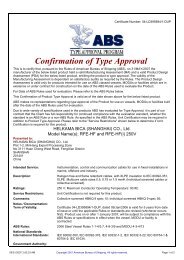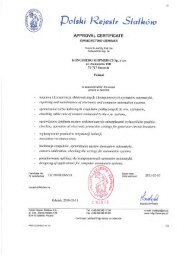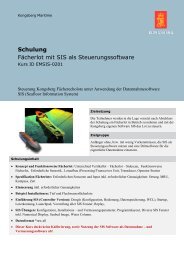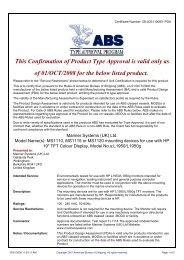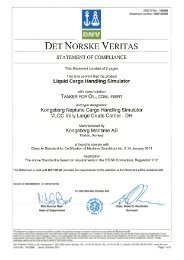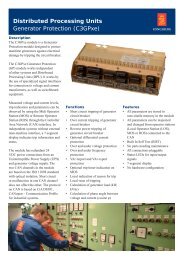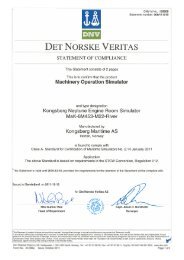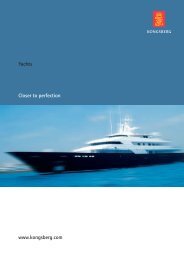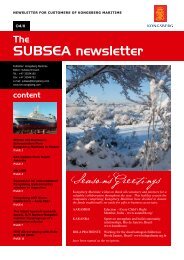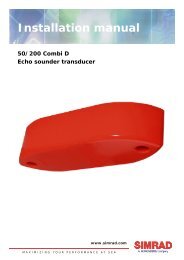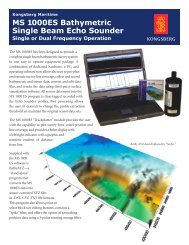Acoustic tracking system, sonar type 2059 - Kongsberg Maritime
Acoustic tracking system, sonar type 2059 - Kongsberg Maritime
Acoustic tracking system, sonar type 2059 - Kongsberg Maritime
Create successful ePaper yourself
Turn your PDF publications into a flip-book with our unique Google optimized e-Paper software.
<strong>Kongsberg</strong> <strong>Maritime</strong><br />
System Description<br />
<strong>Acoustic</strong> Tracking System<br />
Sonar Type <strong>2059</strong><br />
Sonar Type <strong>2059</strong> is a military off the shelf (MOTS) <strong>Acoustic</strong> Tracking System<br />
specifically designed for naval applications including Mine Counter Measures<br />
(MCM).<br />
The portable ruggedised equipment is<br />
manufactured to provide a high degree of<br />
reliability and durability in the harshest of marine<br />
Control Unit<br />
The portable control unit contains: the<br />
transceiver, interface modules and MMI. The<br />
control unit comprises a laptop PC and a number<br />
of data acquisition cards to perform <strong>sonar</strong><br />
processing and data presentation within a<br />
standard Windows ® format. The MMI allows the<br />
operator to correct for weapons datum reference,<br />
transducer alignment and several other<br />
parameters.<br />
A vertical reference unit (VRU) would<br />
normally be incorporated within the <strong>system</strong> to<br />
compensate for vessel motion. This may be an<br />
environments. All assembly is carried out in a<br />
low-magnetic environment.<br />
With over 30 <strong>system</strong>s supplied for naval<br />
applications ranging from submarine rescue to<br />
MCM and salvage operations, the performance is<br />
well proven with components, spares assemblies<br />
and “Special to Type” test equipment all NATO<br />
codified.<br />
The <strong>system</strong> comprises three main units: the<br />
control unit, the transducer assembly and the<br />
underwater transponder (or responder).<br />
interface from the vessel’s MRU or can be<br />
provided by a dedicated self-contained <strong>2059</strong> VRU<br />
unit. The VRU connects to the control unit via an<br />
interconnecting cable and transmits the vessel’s<br />
pitch and roll movement information in an<br />
analogue form, which is then used in the position<br />
calculations.<br />
Transducer Configurations<br />
There are three options available for the<br />
transducer array: SSBL, SBL and LBL depending<br />
on the operation requirement.<br />
The SSBL configuration allows for ease of<br />
installation. The transducer is a miniature<br />
hydrophone array containing three receiving<br />
elements and one transmitting element. The<br />
transmitting element generates the interrogation<br />
Note: Specifications may be changed without notice<br />
Publication Ref: KS<strong>2059</strong>
pulse to which the underwater transponder<br />
replies. The three receiving elements are<br />
arranged in an orthogonal pattern and the<br />
transponder return signal direction is computed<br />
from the phase differences between the three<br />
elements.<br />
The SSBL transducer is deployable ‘over the side’<br />
with a portable deployment <strong>system</strong> or via a hull<br />
outfit (as on the HUNT Class MCMV) or via<br />
special adapter plates for submarine installation.<br />
Each SSBL transducer is submitted for analysis<br />
on an acoustic range after manufacture (or<br />
repair). Transducer response is tested in 5º<br />
azimuth (0º to 355º) and 5º depression steps<br />
(0º to 85º). The resulting unique data is supplied<br />
on a CD-ROM with the corresponding transducer.<br />
Upon downloading onto the laptop PC a<br />
calibrated combination is achieved.<br />
NATO codified as 5845-99-768-6317, the SSBL<br />
transducer comprises three raised ceramic<br />
elements allowing improved shallow water<br />
<strong>tracking</strong> performance. Accurate target <strong>tracking</strong> is<br />
dependent upon correct alignment of the<br />
transducer with the VRU and the vessel’s datum.<br />
It is also important to ensure accurate and timely<br />
provision of target depth data (Manual,<br />
Telemetry and External depth options) and<br />
correct entry of the velocity of sound (VOS) in<br />
water.<br />
In an SBL configuration, the three receive<br />
elements are mounted some distance apart in a<br />
known pattern along with a transmit element (for<br />
transponder operations). The <strong>system</strong> calculates<br />
position from the time delay from the<br />
responder/transponder to each of the receive<br />
elements. Receiver elements may be vessel<br />
mounted or deployed on the seabed for precision<br />
positioning of ROV mounted responders and diver<br />
transponders.<br />
The LBL configuration may be useful when<br />
positioning the vessel accurately on a noise or<br />
magnetic range facility. Up to five seabed<br />
transponders deployed in known positions can be<br />
used to accurately calculate and display the<br />
vessel position. The LBL principle has been<br />
adopted for positioning a rescue vessel (or<br />
MOSUB) using Submerged Signal Ejector (SSE)<br />
launched transponders in close proximity to the<br />
DISSUB and for monitoring a three point moor on<br />
Sal Class vessels.<br />
Transponders/Responders<br />
Transponders generate an acoustic pulse in<br />
response to the acoustic interrogation signal from<br />
the transducer. The acoustic response can be<br />
configured to provide a depth telemetry signal.<br />
One transponder must be fitted to each<br />
underwater unit that is required to be tracked.<br />
The <strong>system</strong> can also be used with underwater<br />
responders in place of transponders. These are<br />
very similar with the exception that they provide<br />
an acoustic reply to an electrical trigger supplied<br />
via an umbilical cable.<br />
The <strong>system</strong> also has the capability of <strong>tracking</strong> a<br />
free running 30kHz acoustic pinger in place of<br />
transponders/responders.<br />
A range of transponders and responders are<br />
available to suit particular MCM vehicle<br />
configurations, SSE deployment mechanisms and<br />
other naval applications.<br />
System Performance<br />
Limitations can be avoided by careful installation<br />
of the acoustic elements of the <strong>system</strong>. It is<br />
particularly important that the transducers are<br />
mounted away from any props and thrusters that<br />
may introduce air into the water surrounding the<br />
acoustic elements. It is recommended that the<br />
transducer be lowered several metres beneath<br />
the hull to reduce vessel generated noise and<br />
aeration effects. The quality of cabling between<br />
the transducer and the control unit can also<br />
impact upon the performance of the <strong>system</strong> as<br />
well as correct alignment of the VRU.<br />
It is also important that effective frequency<br />
management is practiced in the immediate<br />
underwater environment. The control unit is<br />
provided with a synchronisation facility to<br />
manage transmissions into the water.<br />
System performance can be enhanced by<br />
integration of ROV depth information directly into<br />
the control unit. Alternatively the control unit has<br />
the options to calculate depth from the received<br />
signal, interpret depth telemetry or take<br />
manually entered depth into the positional<br />
Note: Specifications may be changed without notice<br />
Publication Ref: KS<strong>2059</strong>
algorithms. Accuracy is enhanced by providing<br />
the <strong>system</strong> with the correct local water sound<br />
velocity.<br />
HUNT Class MCMV<br />
Torpedo Recovery ROV<br />
Technical Overview<br />
SSBL System Performance Characteristics<br />
Tracking Range<br />
(Slant Range)<br />
Range Resolution<br />
Range Accuracy<br />
(Wide Vertical Beam<br />
±90º)<br />
Vanguard Class acting as MOSUB<br />
Submarine Rescue ROV<br />
Up to 2500m<br />
(Transponder<br />
dependent)<br />
Typically 1000m with<br />
the VTM2 Transponder<br />
(186dB source level at<br />
30kHz)<br />
0.1m displayed at MMI<br />
±0.3m (95% of 200<br />
sample readings) at a<br />
range of 300m –<br />
measured at the MoD<br />
<strong>Acoustic</strong> Test Facility<br />
Operating Depth Up to 2500m<br />
(Transponder<br />
dependent)<br />
Depth Telemetry ±0.9m over 95% of<br />
500 sample readings at<br />
a static target depth of<br />
16m – recorded at the<br />
MoD <strong>Acoustic</strong> Test<br />
Facility. (Transponder<br />
dependent)<br />
Tracking Coverage 0º to 360º azimuth<br />
over full hemisphere –<br />
5 transponders and 5<br />
responders sequentially<br />
Bearing Repeatability ±1.0º (95% of 400<br />
sample readings) at a<br />
range of 250m –<br />
recorded at a NATO<br />
Note: Specifications may be changed without notice<br />
<strong>Acoustic</strong> Test Facility<br />
on a MCM vessel<br />
Bearing Resolution 0.1º metres displayed<br />
at MMI<br />
Bearing Accuracy Calibrated to ±1.0º<br />
azimuth for depression<br />
angles 0º to 85º -<br />
recorded at the MoD<br />
Test Facility<br />
Interrogation Rate ASAP – 1.2 seconds at<br />
500m range using a<br />
transponder<br />
Fast – 3.2 seconds at<br />
500m range using a<br />
transponder<br />
Slow – 5.2 seconds at<br />
500m range using a<br />
transponder<br />
Polar Format<br />
Range (R), Bearing (θ),<br />
Depth (Z), Slant Range<br />
(S), Concentric rings at<br />
20%, 40%, 60%, 80%<br />
and 100% of display<br />
range<br />
Rectangular Format Athwartships distance<br />
(X), Alongships<br />
distance (Y), depth (Z),<br />
Slant Range (S),<br />
Horizontal lines at<br />
20%, 40%, 60%, 80%<br />
and 100% of display<br />
range<br />
Note: Accuracy figures can be misleading; the realistic<br />
figures provided above were measured at<br />
internationally approved acoustic test facilities. The<br />
bearing repeatability figure is based on a minimum<br />
20dB SNR at the receiver.<br />
NATO Stock Numbers<br />
Control Unit 5845–99-323-1070<br />
SSBL Transducer 5845-99-768-6317<br />
VRU (Vessel fit) 5845-99-746-5152<br />
VRU (Transducer fit) 5845-99-841-9142<br />
Naval, Versatile<br />
5845-99-957-6424<br />
Transponder Marker 2<br />
Submarine Launch<br />
5845-99-325-0387<br />
Transponder<br />
Transducer Deployment 5845-99-500-8446<br />
System<br />
Sonar Test Set 5845-99-765-3974<br />
Transponder Test Device 5845-99-160-3880<br />
Transducer Tester 5845-99-795-1015<br />
Publication Ref: KS<strong>2059</strong><br />
KONGSBERG MARITIME LTD<br />
11 The Briars Waterberry Drive Waterlooville Hants PO7 7YH<br />
tel: +44 23 9224 7800 fax: +44 23 9224 7808 email: km.waterlooville.uk@kongsberg.com<br />
www.kongsberg.com



